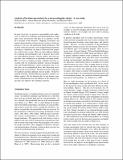| dc.contributor.author | Melo, Gabriela | |
| dc.contributor.author | Malcolm, Alison E. | |
| dc.contributor.author | Poliannikov, Oleg V. | |
| dc.contributor.author | Fehler, Michael | |
| dc.contributor.other | Massachusetts Institute of Technology. Earth Resources Laboratory | |
| dc.date.accessioned | 2014-10-02T13:52:35Z | |
| dc.date.available | 2014-10-02T13:52:35Z | |
| dc.date.issued | 2013 | |
| dc.identifier.uri | http://hdl.handle.net/1721.1/90520 | |
| dc.description.abstract | In many reservoirs, an increase in permeability and conductivity is achieved by hydraulic fracturing/stimulations which open cracks and fractures that then act as pathways for fluids to navigate in the subsurface. Mapping, localization, and
general characterization of these fracture systems is of key importance in oil, gas, and geothermal energy production. The location of the microseismic events triggered during hydraulic fracturing or stimulation can help to characterize the properties of the fracture system. There are many different methods for localizing microearthquakes and, in general, these methods yield different locations, velocity models, and event origin times, due to differences in algorithms and input models. Here we focus on studying location confidence intervals associated with two localization methods, classical (triangulation) and Double-Difference, where uncertainties due to origin times can be marginalized away, thus decreasing uncertainties in the event locations. We relocate events using these two methods and three different velocity models. Of the two methods used here, Double-Difference produces smallest confidence regions. We also illustrate that, for our dataset in particular, marginalizing away the influence of the unknown origin times also improves the confidence intervals. | en_US |
| dc.description.sponsorship | United States. Dept. of Energy (Grant DE-FG36-08GO18197); National Science Foundation (U.S.) (Grant DMS1115406); Massachusetts Institute of Technology. Earth Resources Laboratory (Founding Members Consortium) | en_US |
| dc.language.iso | en_US | en_US |
| dc.publisher | Massachusetts Institute of Technology. Earth Resources Laboratory | en_US |
| dc.relation.ispartofseries | Earth Resources Laboratory Industry Consortia Annual Report;2013-15 | |
| dc.subject | Microseismic | |
| dc.subject | Inversion | |
| dc.subject | Interferometry | |
| dc.title | Analysis of location uncertainty for a microearthquake cluster: A case study | en_US |
| dc.type | Technical Report | en_US |
